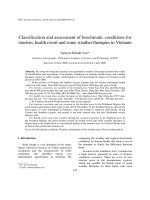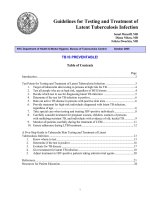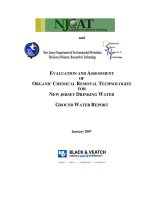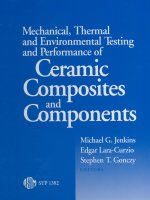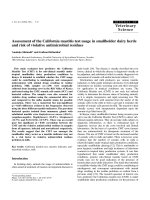Testing and assessment of FRP strengthened concrete T-beam bridges in Pennsylvania
Bạn đang xem bản rút gọn của tài liệu. Xem và tải ngay bản đầy đủ của tài liệu tại đây (13.83 MB, 233 trang )
TESTING AND ASSESSMENT OF FRP
STRENGTHENED CONCRETE T-BEAM BRIDGES IN
PENNSYLVANIA
Adam L. Justice
Thesis submitted to the
College of Engineering and Mineral Resources
at
West Virginia University
in partial fulfillment of the requirements
for the degree of
Master of Science
in
Civil and Environmental Engineering
Julio F. Davalos, Ph. D., Chair
An Chen, Ph. D., Co-Chair
Indrajit Ray, Ph. D.
Department of Civil and Environmental Engineering
Morgantown, West Virginia
2010
Keywords: fiber reinforced polymer (FRP), concrete t-beam bridge, load testing, finite
element model (FEM), load rating, live load distribution, FRP strengthening design
UMI Number: 1486792
All rights reserved
INFORMATION TO ALL USERS
The quality of this reproduction is dependent upon the quality of the copy submitted.
In the unlikely event that the author did not send a complete manuscript
and there are missing pages, these will be noted. Also, if material had to be removed,
a note will indicate the deletion.
UMI 1486792
Copyright 2010 by ProQuest LLC.
All rights reserved. This edition of the work is protected against
unauthorized copying under Title 17, United States Code.
ProQuest LLC
789 East Eisenhower Parkway
P.O. Box 1346
Ann Arbor, MI 48106-1346
Testing and Assessment of FRP Strengthened Concrete TBeam Bridges in Pennsylvania
Adam Levi Justice
Dr. Julio F. Davalos, Thesis Advisor
Abstract
It is increasingly becoming of great concern that the transportation infrastructure
is in poor condition and in need of rehabilitation. Reinforced concrete (RC) structures
such as bridges are a prime example for displaying rehabilitation needs. Harsh
environmental conditions and age, along with the use of deicing salts in the winter
seasons, greatly increase deterioration rates. Addressing bridge conditions in an effective
manner and ensuring the safety of the public is a challenge for engineers and owners.
The Pennsylvania Department of Transportation – District 3 (PennDOT – D3)
initiated a program to address the condition of their concrete T-Beam bridges. 128
concrete T-Beam bridges constructed between 1920 and 1960 are included in the
district’s bridge inventory. Many of these bridges have become structurally deficient or
obsolete due to aging and deterioration. PennDOT-D3 paired with West Virginia
University researchers to develop a program that would use FRP rehabilitation
technology to repair and strengthen its large number of concrete T-Beam bridges.
The work presented in this thesis focuses on the third phase of a three-phase
project concerning the rehabilitation of bridge #49-4012-0250-1032 built in 1934 near
Sunbury, Pennsylvania. Quality control and assurance was performed with several field
visits during the construction process. Load testing was performed to replicate the load
testing performed prior to rehabilitation in Phase II of the project. Data resulting from
load tests before and after rehabilitation was compared. An FE model of the bridge was
developed and calibrated using field testing data and inspection. The FE model was
subjected to the same loading conditions as applied in the field and also compared for a
more thorough structural evaluation. The FE model was also subjected to AASHTO
standard live loading conditions to investigate current load rating methods for these types
of structures. Discrepancies resulting from accurate FE analyses when compared to
simplified methods of analysis are discussed. Based on existing literature and knowledge
gained throughout the project, design, construction, and testing/long-term monitoring
guidelines were drafted in PennDOT-D3 desired formats. These guidelines are
considered important outcomes for Phase III of the project and for the development of
this thesis. The guidelines were developed for incorporation into PennDOT standard
documentation for the successful transfer of knowledge concerning the FRP repair
technology. With the design guidelines, an FRP design program was created specifically
for simple span concrete T-Beam bridges. The design program is user friendly and
allows for detailed input based on field inspection. The program gives structural
capacities for the original, existing, and strengthened conditions of primary bridge
members. Load rating factors are also presented for the existing and strengthened TBeam analysis.
ACKNOWLEDGEMENTS
The author would like to thank West Virginia University for an exciting and
educational life experience. More professors than can be named have had many positive
influences on the author. With this, special thanks should go to the faculty members of
the Department of Civil and Environmental Engineering. Among these influential faculty
members, the guidance and support offered by Dr. Davalos, Dr. Chen, and Dr. Ray will
never be forgotten.
The author would like to thank Dr. Davalos for the opportunity to achieve desired
educational goals. His cultured personality, enthusiasm for teaching, and passion for life
in general has helped the author have a more enjoyable and well rounded graduate
education.
The author would especially like to thank Dr. Chen and Dr. Ray for their never
ending advice and optimistic attitude. Discussions concerning research and general life
matters have led to the development of a strong professional bond and a strong
friendship. Dr. Chen’s guidance and help with the research was invaluable.
The author also owes many thanks to the classmates and officemates throughout
the years. The laughter shared and the help provided can never be replaced. Giving this,
separate thanks must go to Matt Anderson, a fellow graduate student, and to Jared
Grimm, a research technician. Without these two men, a large part of the research could
have never been completed.
Thanks to the author’s mom and brothers shall be given for there support and
encouragement throughout the years.
iii
Table of Contents
ABSTRACT............................................................................................................................................. ii
ACKNOWLEDGMENTS................................................................................................................................ iii
TABLE OF CONTENTS................................................................................................................................. iv
LIST OF FIGURES........................................................................................................................................ vi
LIST OF TABLES ......................................................................................................................................... ix
CHAPTER 1 – INTRODUCTION
1.1
1.2
1.2.1
1.2.2
1.2.3
1.2.4
1.3
1.4
PROJECT BACKGROUND ............................................................................................................... 1
SELECTED BRIDGE AND PREVIOUS PROJECT WORK ..................................................................... 4
Bridge Description.................................................................................................................. 4
In-situ Material Evaluation ..................................................................................................... 5
Testing and FE Modeling of Existing Bridge ......................................................................... 6
FRP Design and Bridge Repair............................................................................................... 8
OBJECTIVES AND SCOPE ............................................................................................................. 10
ORGANIZATION .......................................................................................................................... 11
CHAPTER 2 – LITERATURE REVIEW
2.1
2.2
2.3
2.4
2.4.1
2.5
INTRODUCTION........................................................................................................................... 13
TRANSPORTATION INFRASTRUCTURE EVALUATION ................................................................... 13
FRP CONSTRUCTION AND DESIGN SPECIFICATIONS ................................................................... 15
LONG-TERM MONITORING ......................................................................................................... 17
Infrared Thermography......................................................................................................... 18
CASE STUDIES ............................................................................................................................ 19
CHAPTER 3 – LOAD TESTING AND FE MODELING
3.1
INTRODUCTION........................................................................................................................... 28
3.2
TESTING OF REPAIRED BRIDGE .................................................................................................. 28
3.2.1
Setup ..................................................................................................................................... 28
3.2.1.1
3.2.1.2
3.2.1.3
3.2.1.4
Strain Gages .................................................................................................................................... 29
LVDT’s................................................................................................................................... 33
Accelerometer ......................................................................................................................... 34
Data Acquisition Setup ........................................................................................................... 35
3.2.2
Trucks ................................................................................................................................... 36
3.2.3
Static Load Cases.................................................................................................................. 38
3.2.4
Dynamic Load Cases ............................................................................................................ 40
3.2.5
Testing Results ..................................................................................................................... 40
3.3
FINITE ELEMENT ANALYSIS OF REPAIRED BRIDGE .................................................................... 55
3.3.1
FE Modeling ......................................................................................................................... 55
3.3.2
Dynamic Response Analysis ................................................................................................ 63
CHAPTER 4 – DESIGN PROGRAM
4.1
INTRODUCTION........................................................................................................................... 65
4.2
PROGRAM DESCRIPTION ............................................................................................................. 66
4.2.1
General ................................................................................................................................. 66
4.2.2
Flexural Input ....................................................................................................................... 67
4.2.2.1 Beam Dimensions ............................................................................................................................ 68
4.2.2.2 Longitudinal Reinforcement Details ................................................................................................ 68
4.2.2.3
Material Properties.................................................................................................................. 70
iv
4.2.2.4 Loading ............................................................................................................................................ 70
4.2.2.5 FRP Layout ...................................................................................................................................... 71
4.2.3
Flexural Output..................................................................................................................... 72
4.2.3.1 Service Stresses................................................................................................................................ 74
4.2.3.2 Intermediate Values.......................................................................................................................... 74
4.2.3.3 Termination Point............................................................................................................................. 75
4.2.3.4 Plots.................................................................................................................................................. 76
4.2.4
Shear Input............................................................................................................................ 79
4.2.4.1 Shear Reinforcement Details............................................................................................................ 80
4.2.4.2
Loading .................................................................................................................................. 83
4.2.4.3 FRP Layout ...................................................................................................................................... 83
4.2.5
Shear Output ......................................................................................................................... 85
4.2.5.1 Intermediate Values.......................................................................................................................... 88
4.2.5.2 U-Wrap Anchor Requirement .......................................................................................................... 88
4.2.5.3 Shear Diagram.................................................................................................................................. 89
4.2.6
4.2.7
Rating Factors....................................................................................................................... 89
Saving and Loading Results ................................................................................................. 92
CHAPTER 5 – DESIGN AND ANALYSIS CORRELATIONS
5.1
5.2
5.3
5.4
INTRODUCTION........................................................................................................................... 94
MOMENT AND SHEAR FORCE COMPUTATION ............................................................................. 94
LOAD RATING FACTOR BASED ON FE MODEL ........................................................................... 95
LIVE LOAD DISTRIBUTION FACTORS .......................................................................................... 98
CHAPTER 6 – QUALITY CONTROL AND ASSURANCE
6.1
INTRODUCTION......................................................................................................................... 107
6.2
QUALITY CONTROL ASSISTANCE ............................................................................................. 107
6.2.1
Concrete Demolition........................................................................................................... 108
6.2.2
Cross-Section Restoration .................................................................................................. 110
6.2.3
On-Site Pull-Off Testing..................................................................................................... 113
6.2.4
FRP Installation .................................................................................................................. 114
6.3
QUALITY ASSURANCE ASSISTANCE ......................................................................................... 117
6.3.1
Cylinder Testing of AAA Repair Concrete ........................................................................ 117
6.3.2
Cylinder Testing of Bag Repair Material............................................................................ 118
6.3.3
Bond Strength between Old and New Concrete ................................................................. 120
6.3.4
Prism Rebound Hammer Tests ........................................................................................... 122
6.3.5
Bond Strength between Concrete and FRP......................................................................... 123
6.3.6
Tension Testing of FRP Coupon Samples .......................................................................... 126
CHAPTER 7 - CONCLUSIONS
7.1
7.2
7.3
7.4
7.5
INTRODUCTION......................................................................................................................... 129
LOAD TESTING AND FE MODELING ......................................................................................... 130
DESIGN PROGRAM.................................................................................................................... 131
QUALITY CONTROL AND ASSURANCE ...................................................................................... 132
RECOMMENDATIONS AND FUTURE WORK ............................................................................... 133
REFERENCES........................................................................................................................................... 138
APPENDIX A: ORIGINAL BRIDGE DRAWINGS ......................................................................................... 142
APPENDIX B: FRP DESIGN LAYOUT ...................................................................................................... 145
APPENDIX C: PROJECT SELECTION FORMS ............................................................................................ 149
APPENDIX D: DESIGN GUIDELINES ........................................................................................................ 151
APPENDIX E: CONSTRUCTION GUIDELINES............................................................................................ 199
APPENDIX F: LONG-TERM TESTING AND MONITORING GUIDELINES ..................................................... 218
v
List of Figures
Figure 1.1 Bridge Girder Elevation View (Sasher, 2008) ................................................ 4
Figure 1.2 Bridge Girder Cross-Section View (Sasher, 2008) ......................................... 5
Figure 1.3 Bridge Condition Photographs ........................................................................ 5
Figure 1.4 Beam 1 and 2 FRP Reinforcement .................................................................. 9
Figure 1.5 Beam 5 FRP Reinforcement............................................................................ 9
Figure 3.1 Plan View Instrumentation Setup.................................................................. 29
Figure 3.2 Strain Gage Layout on Web .......................................................................... 30
Figure 3.3 Surface Preparation ....................................................................................... 31
Figure 3.4 Gage on Flexural FRP ................................................................................... 32
Figure 3.5 Concrete Gage with Barrier E Protective Coating ........................................ 32
Figure 3.6 Cross-Section View of LVDT Setup............................................................. 33
Figure 3.7 LVDT Setup .................................................................................................. 33
Figure 3.8 Overall Test Setup ......................................................................................... 34
Figure 3.9 PCB 393B Accelerometer Mounted.............................................................. 35
Figure 3.10 Cross-Section View Instrumentation Setup................................................. 35
Figure 3.11 Data Acquisition Setup................................................................................ 36
Figure 3.12 Truck 1......................................................................................................... 37
Figure 3.13 Truck 2......................................................................................................... 37
Figure 3.14 Load Cases................................................................................................... 39
Figure 3.15 Modified Load Cases................................................................................... 39
Figure 3.16 Load Case 1 Deflection Results .................................................................. 42
Figure 3.17 Load Case 2-2 Deflection Results ............................................................... 43
Figure 3.18 Load Case 2-1 Deflection Results ............................................................... 43
Figure 3.19 Load Case 4 Deflection Results .................................................................. 44
Figure 3.20 Load Case 5 Deflection Results .................................................................. 44
Figure 3.21 Load Case 6 Deflection Results .................................................................. 45
Figure 3.22 Symmetry of Repaired Bridge..................................................................... 45
Figure 3.23 Modified 1 Deflection Results..................................................................... 46
Figure 3.24 Modified 2 Deflection Results..................................................................... 46
Figure 3.25 Load Case 1 Strain Results.......................................................................... 47
Figure 3.26 Load Case 2-2 Strain Results ...................................................................... 48
Figure 3.27 Load Case 2-1 Strain Results ...................................................................... 48
Figure 3.28 Load Case 4 Strain Results.......................................................................... 49
Figure 3.29 Load Case 5 Strain Results.......................................................................... 49
Figure 3.30 Load Case 6 Strain Results.......................................................................... 50
Figure 3.31 Modified 1 Strain Results............................................................................ 50
Figure 3.32 Modified 2 Strain Results............................................................................ 51
Figure 3.33 Concrete Strain from Load Case #1 (G1).................................................... 52
Figure 3.34 Concrete Strain from Modified #1 (G2)...................................................... 52
Figure 3.35 Concrete Strain from Modified #2 (G3)...................................................... 52
Figure 3.36 Concrete Strain from Load Case #1 (G4).................................................... 53
Figure 3.37 Concrete Strain from Load Case #2-2 (G5) ................................................ 53
Figure 3.38 Concrete Strain from Modified #2 (G6)...................................................... 53
vi
Figure 3.39 Natural Frequency Chart ............................................................................. 54
Figure 3.40 Rebar System of the Model ......................................................................... 59
Figure 3.41 Reinforcing FRP System of Model ............................................................. 60
Figure 3.42 Meshed FE Model ....................................................................................... 60
Figure 3.43 Wheel Spacing Comparison ........................................................................ 61
Figure 3.44 Tandem Truck Load Position ...................................................................... 62
Figure 3.45 Vertical Deformation Contour Plot ............................................................. 62
Figure 3.46 In-plane Stress View Cut............................................................................. 63
Figure 3.47 Mode Shapes and Frequencies .................................................................... 64
Figure 4.1 Tabbing Organization of Program................................................................. 66
Figure 4.2 Flexural Input Section of Program ................................................................ 67
Figure 4.3 Enlarged Flexural Steel Details Panel ........................................................... 68
Figure 4.4 Longitudinal Steel Input Dialog Box - 2 and 3 Layers Selected................... 69
Figure 4.5 FRP Width Error Dialog Box ........................................................................ 72
Figure 4.6 Flexural Output Tab ...................................................................................... 73
Figure 4.7 Enlarged Intermediate Values Panel ............................................................. 75
Figure 4.8 Factored Moment and Cracking Moment...................................................... 77
Figure 4.9 Example Cross-Section Diagram .................................................................. 77
Figure 4.10 Example Elevation Diagram........................................................................ 78
Figure 4.11 Example Cross-Section Strain Plot ............................................................. 78
Figure 4.12 Shear Specific Input Section of Program .................................................... 79
Figure 4.13 Enlarged Shear Sections Selection Menu.................................................... 81
Figure 4.14 Input Dialog Boxes for Shear Sections - 4 Sections Selected ..................... 82
Figure 4.15 Section Distance Error Dialog Box ............................................................. 82
Figure 4.16 FRP Shear Reinforcement for 8 Sections.................................................... 84
Figure 4.17 FRP Shear Reinforcement for 4 Sections.................................................... 84
Figure 4.18 Example Shear Output - 8 Shear Sections................................................... 86
Figure 4.19 Example Shear Output – 4 Shear Sections .................................................. 87
Figure 4.20 Enlarged Shear Intermediate Values Panel ................................................. 88
Figure 4.21 Rating Factors Section of Program.............................................................. 90
Figure 4.22 Shear Rating Factors - 4 Sections Selected ................................................. 92
Figure 4.23 File Menu - Save ......................................................................................... 92
Figure 4.24 Saved and Load File Name.......................................................................... 93
Figure 5.1 Interior Live Load Moment Distribution Factors........................................ 102
Figure 5.2 Exterior Live Load Moment Distribution Factors....................................... 103
Figure 5.3 Comparison of AASHTO Standard and AASHTO LRFD LDF Values..... 105
Figure 6.1 Concrete Demolition – (a) Beam 1 (b) Beam 6........................................... 108
Figure 6.2 Missing Reinforcement Exposed in Beam 6 ............................................... 109
Figure 6.3 Concrete Restoration Area .......................................................................... 111
Figure 6.4 Patch Repairing Formwork along Beams 3 & 4.......................................... 112
Figure 6.5 Patch Formwork Detail................................................................................ 112
Figure 6.6 Formwork along (a) Beam 5 & (b) Beam 1 ................................................ 112
Figure 6.7 Patch Surface & Adhesion Testing Attachment.......................................... 113
Figure 6.8 FRP Reinforcement Layout (a) Beam 1 & (b) Beam 5 ............................... 115
Figure 6.9 FRP Reinforcement Layout for Beams 2 & 3 ............................................. 115
Figure 6.10 Testing Prism FRP Application (a) Primer (b) Saturant (c) Fiber Sheet... 116
vii
Figure 6.11
Figure 6.12
Figure 6.13
Figure 6.14
Figure 6.15
Figure 6.16
Figure 6.17
Figure 6.18
Figure 6.19
Figure 6.20
FRP Panel Fabrication for Tension Testing .............................................. 117
Bag Material Cylinder Tests (a) Compression (b) Splitting-Tensile......... 119
Schematics of Pull-Off Test for Material Interface................................... 120
Concrete Pull-Off Test (a) Drill Setup (b) Tested Core ............................ 120
Dyna Z16 Pull-Off Tester.......................................................................... 121
Pull-Off Testing Preparation (a) Cutting (b) Attached Disks.................... 124
FRP Pull-Off Test (a) Mounted Tester (b) Cohesive Failure .................... 125
FRP Coupon Tension Test Setup .............................................................. 127
1-Ply Tension Coupon Samples ................................................................ 128
2-Ply Tension Coupon Samples ................................................................ 128
viii
List of Tables
Table 3-1
Table 3-2
Table 3-3
Table 3-4
Table 5-1
Table 5-2
Table 5-3
Table 5-4
Table 6-1
Table 6-2
Table 6-3
Table 6-4
Table 6-5
Table 6-6
Table 6-7
Exact Strain Gage Locations .......................................................................... 30
Summary of Static Load Cases....................................................................... 38
Properties of MBrace CF 130......................................................................... 58
Wheel Loading (lbs) for AASHTO HS20 and Tandem Trucks ..................... 61
Maximum Moments and Shear Forces for Girders ........................................ 95
Girder Rating Factors ..................................................................................... 96
Comparison of AASHTO Live Load Moment Distribution Factors............ 101
Regression Function of Distribution Factors (Zou, 2008) ........................... 102
Field Adhesion Testing Results of Repair Material ..................................... 114
FRP Wrapping Scheme ................................................................................ 115
PennDOT Provided Compressive Strength (AAA)...................................... 118
WVU Provided Strength and Modulus of Elasticity (AAA)........................ 118
Bag Repairing Material Testing Results....................................................... 119
Rebound Hammer Test Results .................................................................... 123
FRP Bond Strength of Field Testing ............................................................ 124
ix
1 CHAPTER 1 – INTRODUCTION
1.1
PROJECT BACKGROUND
Reinforced concrete (RC) structures such as bridges are increasingly in need of
rehabilitation as a result of deterioration. In colder regions, deterioration results largely
from the use of deicing salts to clear roadways in the winter seasons. These deicing salts
lead to chloride ingression which eventually corrodes the reinforcing steel. The corrosion
product of the steel (rust) tends to occupy much more volume, leading to spalling of
concrete cover and section loss of rebar. Due to the large quantity of RC bridges
reaching this condition, repair and strengthening must be performed as economically as
possible.
The Pennsylvania Department of Transportation – District 3 (PennDOT – D3)
initiated a program to address the condition of their concrete T-Beam bridges. 128
concrete T-Beam bridges constructed between 1920 and 1960 are included in the
district’s bridge inventory. Due to deterioration, many of these bridges are in need of
repair and strengthening.
The program initiated by PennDOT – D3 incorporates the use of externally
bonded fiber-reinforced polymers (FRP) to strengthen deteriorated bridges.
The
strengthening will effectively improve the load capacity and remove load restrictions on a
bridge in an economical fashion. The project has been carried out in three phases as
explained below. The work presented in this thesis focuses on the majority of tasks
performed in Phase III.
1
In Phase I, technical and economic feasibility of different rehabilitation options
were considered along with developing a preliminary selection process for these options.
The preliminary selection process developed in this phase used several factors including:
age, span length, average daily traffic and average daily truck traffic (ADT/ADTT), and
damage based on photographic evidence as well as visual inspection (Brayack, 2005). A
bridge was placed into one of three classes based on this selection system. These classes
included: Class 1 (prime candidate), Class 2 (moderate candidate), and Class 3 (low
candidate. Based on the proposed classification system, a Class 1 candidate bridge was
chosen and Phase II of the project was started.
It should be stated here that throughout Phase III of the project, two additional
factors were added to the bridge selection process. These factors include the functional
class of highway that a given bridge serves and the bridge capacity appraisal of a bridge.
Functional class of highway shall be deemed important as it considers the type of route
such as interstate, principal arterial, minor arterial, etc. that a bridge facilitates and
thereby directly relates to the importants of that transportation segment. Bridge capacity
appraisal inclusion into the selection process was deemed necessary as it gives insight
into the structural capacity of a bridge in relation to allowable state legal loads. The ratio
of the capacity to the legal load can lead to logical determinations as to whether or not
any type of repair could be favorable as apposed to total replacement. Low ratios should
suggest replacement whereas high ratios could suggest minor repair to be sufficient. This
updated project selection system was incorporated into a drop-down form as well as a
simple Graphical User Interface (GUI) for quick bridge assessments.
2
Updating the
project selection process was an important outcome carried out in Phase III, and as such,
the proposed project selection form and GUI are presented in Appendix C.
Phase II work consisted of performing bridge condition assessment and
preliminary FRP strengthening design (Sasher, 2008). Load testing was carried out on
the bridge prior to strengthening in an effort to evaluate pre- and post-retrofitting effects.
An externally bonded FRP strengthening design program was developed using Excel
during this Phase. The program also incorporated a live load generator in which load
rating factors based on various AASHTO live loadings could be computed. This live
load generator was developed in an effort to understand how PennDOT’s load rating and
analysis program (BAR7) worked.
Phase III includes the implementation of the FRP strengthening system and poststrengthening load testing and assessment.
Using established specifications and
information gathered during much of the project, various guidelines relating to FRP
strengthening were to be developed in PennDOT desired formats. The development of
these guidelines was considered a significant contribution to Phase III of the project. The
guidelines are also an important component of this thesis. The intention was that draft
guidelines could eventually be incorporated into PennDOT’s standard design manuals
and construction specifications. This thesis focuses on the tasks, results, and work
outcomes of Phase III activities.
With the completion of this project, PennDOT – D3 will have obtained the
information and knowledge necessary to implement a rehabilitation program that will
enable district forces to independently classify, evaluate, and rehabilitate concrete TBeam bridges in an economical manner using FRP strengthening systems. Based on the
3
extensiveness of the repair, PennDOT shall either: contract out all work (Level 1 repair),
combine outside contracting with inside district forces (Level 2 repair), or perform the
work entirely with district forces (Level 3 repair).
1.2
SELECTED BRIDGE AND PREVIOUS PROJECT WORK
1.2.1
Bridge Description
The bridge selected for this demonstration project was constructed in 1934 and is
located near Sunbury, Pennsylvania (PennDOT Bridge #49-4012-0250-1032).
bridge carries two traffic lanes on Creek Road over a small creek.
The
It is a simply
supported concrete T-Beam structure spanning 48 ft with 45 ft from abutment to
abutment. For analysis purposes, a span length of 45 ft is used. Six beams supporting a
26 ft-11 in wide and 8.5 in thick concrete deck make up the superstructure of the bridge.
Resting on the deck is a 2.5 in asphalt overlay. Figures 1.1 through 1.3 illustrate the
selected bridge, showing various reinforcement layouts and photographical indication of
damage prior to the start of Phase III.
CL
Interior
Beam
Only
Figure 1.1 Bridge Girder Elevation View (Sasher, 2008)
4
Exterior
Interior
Figure 1.2 Bridge Girder Cross-Section View (Sasher, 2008)
Figure 1.3 Bridge Condition Photographs
1.2.2
In-situ Material Evaluation
In assessing the condition of the existing bridge, two core samples were obtained
from the bridge deck using a core drill; one at the mid-span and one at the quarter-point.
Each core represented the entire depth of the deck. A sample of flexural reinforcing steel
5
was taken from the fascia side of beam 6.
This reinforcement sample was easily
extracted as it was completely exposed due to corrosion and spalling of concrete cover.
The core samples were tested in compression in accordance with ASTM C42, and the
average strength was found to be 5783 psi. The flexural reinforcing steel sample was
tested in accordance with ASTM E8. The average yield strength was 37 ksi and the
average ultimate strength was 64 ksi. Also, two non-destructive tests were performed at
the bridge site on the concrete beams: an ultrasonic pulse velocity test in accordance
with ASTM C597, and a rebound hammer test in accordance with ASTM C805. From
the visual inspection, the external beams showed the most damage with severe
delamination and spalling.
The interior beams showed less damage with localized
delamination and spalling.
To recap, several tests and analyses were performed on material samples extracted
from the bridge, including core sample compression test, concrete carbonation test,
Scanning Electron Microscopy (SEM) and Energy Dispersive X-Ray (EDX) analyses,
chemical analysis of concrete powder samples, and steel tension test. All results obtained
from the in-situ material evaluation and bridge sample testing was used for developing
the FE model and for performing accurate strength assessments in designing the FRP
reinforcement layout.
1.2.3
Testing and FE Modeling of Existing Bridge
In order to investigate the response of the selected bridge under various loading
conditions, a field test was conducted by applying tandem truck(s) on one and two lanes.
Field testing data was compared to the results of the FE model in order to verify the
model’s accuracy. Displacement transducers (LVDTs) were used to obtain deflections of
6
the reinforced concrete girders. The natural frequency was determined by utilizing an
accelerometer attached to beam 4. All of the data was recorded at the mid-spans of the
girders, and all of the response data was recorded with a data acquisition system.
The full response of the bridge under loading was observed by crossing the trucks
at several different transverse locations. These locations were selected to maximize the
deflections of the girders. The maximum deflection occurred when the truck’s center of
gravity was directly over the centerlines of the girders. In the static tests, each truck
moved at a crawl speed. In the dynamic tests, the truck approached the bridge at 30 mph
to 50 mph and excited the bridge by slamming on the brakes when approximately over
the mid-span. There were a total of six dynamic load field tests. The data from the
accelerometer showed that the natural frequency of the bridge was about 14.66 Hertz.
The bridge load test is discussed with greater detail in Chapter 3 as it was repeated for the
repaired bridge. Testing of the repaired bridge included the additional implementation of
strain gages. Relative graphs and figures are presented in Chapter 3 as well.
An FE model of the bridge was constructed using the commercial program
ABAQUS (2005). The information for the FE model development and analysis was
acquired from a combination of available design documents (Appendix A) and gathered
field information.
Chapter 3 presents a more detailed discussion of the FE model
construction and analysis. The model was developed in order to determine existing
capacities of the bridge, to identify critical load conditions for field testing, and to
compare predictions with field test responses. Once created, the model was calibrated
using field testing results and modified as needed to enhance its accuracy. After dynamic
analysis, the natural frequency was predicted to be 13.33 Hertz, which is about a 10%
7
difference when compared to the natural frequency of 14.66 Hertz resulting from field
testing.
1.2.4
FRP Design and Bridge Repair
The FRP repair system was designed by the system manufacturer and was
reviewed by WVU based on ACI 440.2R-02 (2002) design guidelines. The FRP design
layout is presented in Appendix B for each beam.
It was initially desired to develop an FRP design that would replace a known area
of corroded reinforcing steel. Although, upon removal of deteriorated concrete from the
exterior beams, it was found that about 20% of the tensile reinforcement and some of the
diagonal shear reinforcing bars and vertical stirrups were missing. It was logically
assumed that the rest of the beams were also missing this reinforcement. With this
finding, a new FRP design approach had to be discussed.
WVU researchers
recommended designing the FRP system to sustain an HS-20 AASHTO truck loading.
More specifically, the FRP strengthening system was designed to increase the capacity of
each beam so that an Inventory Rating Factor (IRF) of at least 1.0 could be achieved.
Load rating factors are discussed in more detail in Chapter 5. In this manner, the design
process did not have to consider any discrepancies between original bridge design plans
and as-built conditions. This method provided a rational basis for design while avoiding
excess application of external FRP reinforcing fabrics. With the success of this design
approach, it could be used as an example for future FRP retrofit projects.
The construction and repair process is discussed in Chapter 6. The repair was
performed in accordance with ACI 546R and ICRI No. 03730 guidelines. Removed
cross-sectional area was restored with concrete repairing materials before FRP
8
application. Figure 1.4 and Figure 1.5 illustrate the applied FRP layout for various
beams.
Figure 1.4 Beam 1 and 2 FRP Reinforcement
Figure 1.5 Beam 5 FRP Reinforcement
9
1.3
OBJECTIVES AND SCOPE
This thesis focuses on the FRP strengthening construction and design work, along
with post-strengthening field testing and Finite Element (FE) analysis. Several visits to
the bridge site were made to observe construction work and FRP application details. The
site visits allowed for an assessment of quality control and quality assurance (QC and
QA) aspects during the rehabilitation project through direct communication with the
contractor and through site inspection. QA testing was performed on site as well as in
West Virginia University laboratories. Extended duration site visits were made upon
completion of the FRP application to perform field testing in an effort to compare with
the results of testing prior to strengthening.
Within the scope of work for this thesis, various guidelines were to be developed
in PennDOT – D3 desired formats. These guidelines included: FRP strengthening
design guidelines in PennDOT DM-4 format, construction guidelines in PennDOT
Publication 408 format, and guidelines for testing and long-term monitoring. DM-4 is
PennDOT’s Design Manual and Publication 408 is PennDOT’s construction
specifications. As a result of the desired formats, all guidelines developed are presented
in the Appendices: FRP strengthening design guidelines (Appendix D), construction
guidelines (Appendix E), and testing/long-term monitoring guidelines (Appendix F).
These guidelines are considered significant contributions to Phase III of the project and to
this thesis. For this reason, Appendix D through Appendix F shall be regarded as
essential components for the comprehensiveness of this thesis.
A user friendly design program was developed to aid the design guidelines. The
program includes many issues and analysis concepts important for concrete T-Beam
10
bridge FRP rehabilitation. The program follows American Association of State Highway
and Transportation Officials (AASHTO) and American Concrete Institute (ACI)
guidelines and specifications (AASHTO 1996, ACI 440.2R-08 2008).
Efforts were made to relate design with analysis.
This was performed by
comparing member force effects resulting from the FE model with resulting force effects
using an AASHTO analysis. Rating factors were computed for each set of force effects,
which give insight as to whether or not standard design methodologies lead to over- or
under-conservative results. Further, several methods for computing live load distribution
factors were used and compared. Field testing and FE model deflection and strain data
was used to compute live load distribution factors. These values were compared with
those obtained via the AASHTO LRFD and AASHTO Standard (LFD) bridge codes, as
well as with those obtained via series solution (Zou, 2008).
1.4
ORGANIZATION
The majority of work performed and undertaken in Phase III of the project is
collected and presented within this thesis. The organization of the above mentioned
thesis work is presented in this section in relation to each chapter. Chapter 2 consists of a
comprehensive literature review detailing transportation infrastructure assessment and
rehabilitation strategies. Founding and existing design and construction specifications
are discussed. Concerns relating to the long-term monitoring of such repair systems are
expressed and various case studies are reviewed. Chapter 3 provides information relating
to field testing and finite element analysis of the repaired bridge. Testing results are
analyzed and discussed. It should be noted that the FE model was created by a separate
researcher. The present author altered loading conditions to this model and analyzed
11
various results. Chapter 4 details all aspects of the design program created for enhancing
the outcomes of the project. This chapter doubles as a user’s manual within the program
itself and can be accessed by simply selecting “Help” in the file menu. Chapter 5
discusses correlations between design and analysis.
The FE model was loaded in
accordance with AASHTO, and comparisons were made between force effects resulting
from the accurate FE model and force effects resulting from AASHTO Standard
specifications.
Discrepancies concerning the different analysis methodologies are
discussed in terms of load rating factors and live load distribution factors. Chapter 6
presents aspects and knowledge gathering based on field visits for quality control and
quality assurance during the repair. During this stage of work, sample testing was
performed both on-site and in the laboratory to assess total work quality. Chapter 7
presents final results and conclusions of the work.
The Appendices present
supplementary details and major project contributions such as the proposed draft
guidelines.
12
2 CHAPTER 2 – LITERATURE REVIEW
2.1
INTRODUCTION
The research review presented here-in was performed in an effort to assess the
structural condition of concrete T-Beam bridges after strengthening with externally
bonded FRP.
Proper evaluation of any structural rehabilitation project cannot be
performed without adequate comparison of the structure before and after retrofit. The
literature review shall also address concerns relating to the long-term performance of
such strengthening systems. Long-term monitoring techniques for evaluating externally
bonded FRP systems for strengthening of RC structures are still largely in the research
phase. The literature review will assist WVU researchers in developing a rehabilitation
program for PennDOT.
2.2
TRANSPORTATION INFRASTRUCTURE EVALUATION
The transportation infrastructure in continuously exposed to environmental
conditions that have major deleterious effects over time. This is especially true in regions
with varying climates that can cause freeze-thaw and wet-dry cycles. The use of deicing
salts during the winter seasons greatly enhances the deterioration.
Along with the
accelerated aging of bridges, more complications arise as a result of inaccurate bridge
records and constantly changing design specifications. Assessing the structural condition
of these bridges has quickly become an important research topic. There is much need for
improving the cost effectiveness of such structural condition assessments as well as a
13
need for economical rehabilitation strategies since the maintenance needs for older
bridges have far outpaced available resources.
As reported by Mayo et al. (1999), over 40% of the nation’s bridges are in need of
repair or replacement due to poor condition ratings that are often subjective and reported
inaccurately. Bridge inspection relies largely on visual assessment which is subjective in
nature. Inspection methods that decrease the degree of subjectivity are greatly needed.
These methods are gaining research interest.
Work should be focused on using
measurable criteria to aid in calculating the reduced load bearing capacities of such
structures.
Pennsylvania has the third largest concrete T-Beam population in the United
States. This means that the state possesses and maintains 2,440 out of the 38,170
concrete T-Beam bridges in the nation (Sasher, 2008). The majority of these bridges
(78%) are simple spans. 60% of these simple span bridges were built before 1950 and
have a maximum life span of 101 years (Catbas et al. 2003). It is also known that these
bridges were supposed to be built in accordance with a standard set of design drawings
which may not accurately depict the as-built conditions of the structure (Catbas et al.
2003). For these reasons, Pennsylvania can serve as a great state to demonstrate the wide
range of applications for rehabilitation with externally bonded FRP.
The use of externally bonded FRP can be very beneficial and economical due to
its ease of installation, high strength to weight ratio, and minimum required application
space. Also, as opposed to traditional methods in which steel plates would be used to
strengthen member, FRP is non-corrosive which decreases future deterioration rates.
14
2.3
FRP CONSTRUCTION AND DESIGN SPECIFICATIONS
Structural strengthening with FRP composite technology has quickly gained
acceptance as a rehabilitation technique with many application possibilities. There has
been much research concerning the complexities and susceptibilities of the short term
performance of FRP composites throughout the last several decades. Using the results
and conclusions of such research, various government agencies have developed
construction and design specifications to allow for the adequate use of FRP technologies
for structural rehabilitation.
In 1991, an assembly of European nations planned one of the first field
applications of FRP composites when the Ibach Bridge in Lucerne, Switzerland was
strengthened. Later, in 1993, a research program was carried out in Europe known as
EUROCRETE for the intended purpose of developing FRP reinforcement for concrete.
Research members from the United Kingdom, Switzerland, France, Norway, and The
Netherlands were included in the program.
FRP has been used for construction purposes in Japan since the 1980s. It wasn’t
until after the Hyogoken Nanbu earthquake in 1995, that FRP technologies were
developed for the retrofit of structures. Following this development, the Japanese quickly
became leaders in the field of FRP reinforcement applications with about 1,000
demonstration/commercial projects in 1997. Also noteworthy, the Japanese were one of
the first civilizations to develop and implement FRP design guidelines which were
incorporated into the standard specifications produced by the Japan Society of Civil
Engineers (Rizkalla et al. 2003).
15
